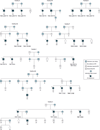Whole-Exome Sequencing in Familial Parkinson Disease
- PMID: 26595808
- PMCID: PMC4946647
- DOI: 10.1001/jamaneurol.2015.3266
Whole-Exome Sequencing in Familial Parkinson Disease
Abstract
Importance: Parkinson disease (PD) is a progressive neurodegenerative disease for which susceptibility is linked to genetic and environmental risk factors.
Objective: To identify genetic variants contributing to disease risk in familial PD.
Design, setting, and participants: A 2-stage study design that included a discovery cohort of families with PD and a replication cohort of familial probands was used. In the discovery cohort, rare exonic variants that segregated in multiple affected individuals in a family and were predicted to be conserved or damaging were retained. Genes with retained variants were prioritized if expressed in the brain and located within PD-relevant pathways. Genes in which prioritized variants were observed in at least 4 families were selected as candidate genes for replication in the replication cohort. The setting was among individuals with familial PD enrolled from academic movement disorder specialty clinics across the United States. All participants had a family history of PD.
Main outcomes and measures: Identification of genes containing rare, likely deleterious, genetic variants in individuals with familial PD using a 2-stage exome sequencing study design.
Results: The 93 individuals from 32 families in the discovery cohort (49.5% [46 of 93] female) had a mean (SD) age at onset of 61.8 (10.0) years. The 49 individuals with familial PD in the replication cohort (32.6% [16 of 49] female) had a mean (SD) age at onset of 50.1 (15.7) years. Discovery cohort recruitment dates were 1999 to 2009, and replication cohort recruitment dates were 2003 to 2014. Data analysis dates were 2011 to 2015. Three genes containing a total of 13 rare and potentially damaging variants were prioritized in the discovery cohort. Two of these genes (TNK2 and TNR) also had rare variants that were predicted to be damaging in the replication cohort. All 9 variants identified in the 2 replicated genes in 12 families across the discovery and replication cohorts were confirmed via Sanger sequencing.
Conclusions and relevance: TNK2 and TNR harbored rare, likely deleterious, variants in individuals having familial PD, with similar findings in an independent cohort. To our knowledge, these genes have not been previously associated with PD, although they have been linked to critical neuronal functions. Further studies are required to confirm a potential role for these genes in the pathogenesis of PD.
Conflict of interest statement
Figures


Comment in
-
Exome Variant Mining in Familial Parkinson Disease: Will Replication Find the Gold?JAMA Neurol. 2016 Jan;73(1):21-2. doi: 10.1001/jamaneurol.2015.3536. JAMA Neurol. 2016. PMID: 26595415 No abstract available.
References
-
- Bonifati V, Rizzu P, van Baren MJ, et al. Mutations in the DJ-1 gene associated with autosomal recessive early-onset parkinsonism. Science. 2003;299(5604):256–259. - PubMed
-
- Zimprich A, Biskup S, Leitner P, et al. Mutations in LRRK2 cause autosomal-dominant parkinsonism with pleomorphic pathology. Neuron. 2004;44(4):601–607. - PubMed
-
- Polymeropoulos MH, Lavedan C, Leroy E, et al. Mutation in the alpha-synuclein gene identified in families with Parkinson’s disease. Science. 1997;276(5321):2045–2047. - PubMed
-
- Kitada T, Asakawa S, Hattori N, et al. Mutations in the parkin gene cause autosomal recessive juvenile parkinsonism. Nature. 1998;392(6676):605–608. - PubMed
-
- Valente EM, Abou-Sleiman PM, Caputo V, et al. Hereditary early-onset Parkinson’s disease caused by mutations in PINK1. Science. 2004;304(5674):1158–1160. - PubMed
Publication types
MeSH terms
Substances
Grants and funding
- U54HG003273/HG/NHGRI NIH HHS/United States
- U54HG006542/HG/NHGRI NIH HHS/United States
- C06RR029965/RR/NCRR NIH HHS/United States
- HHSN268201100011I/HL/NHLBI NIH HHS/United States
- U54 HG003273/HG/NHGRI NIH HHS/United States
- UL1 TR001108/TR/NCATS NIH HHS/United States
- T32 GM077229/GM/NIGMS NIH HHS/United States
- R01 NS037167/NS/NINDS NIH HHS/United States
- T32 GM008307/GM/NIGMS NIH HHS/United States
- R21NS089854/NS/NINDS NIH HHS/United States
- U54 HG006542/HG/NHGRI NIH HHS/United States
- T32 GM007526/GM/NIGMS NIH HHS/United States
- HHSN268201100011C/HL/NHLBI NIH HHS/United States
- TL1 TR000162/TR/NCATS NIH HHS/United States
- C06 RR029965/RR/NCRR NIH HHS/United States
- T32 GM07526-37/GM/NIGMS NIH HHS/United States
- R01NS037167/NS/NINDS NIH HHS/United States
- R21 NS089854/NS/NINDS NIH HHS/United States
- 1X01HG006236/HG/NHGRI NIH HHS/United States
LinkOut - more resources
Full Text Sources
Other Literature Sources
Molecular Biology Databases
Research Materials
Miscellaneous

